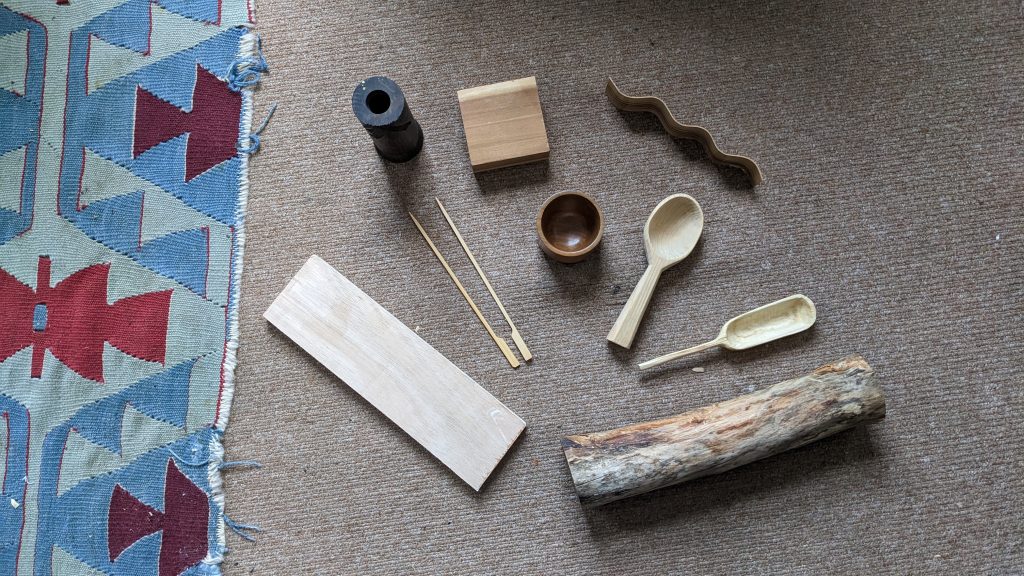Object based learning is a teaching methodology that utilises physical objects as tools for learning. The use of physical or digital objects allows the learner to engage the brain, hands and heart in the subject matter to facilitate critical thinking.
‘OBL supports active participation through aisthesis (Bleakley, 1999) and embodied learning (Chatterjee et al., 2016); the combining of the working with the head (cognitive dimension), the hands (psychomotor dimension), and the heart (affective dimension); thus, it is a powerful pedagogy for facilitating critical thinking and behaviour change.’[i]
Other learning benefits from OBL:
- Accessibility
- Embodied knowledge
- Sensory learning
- Participation and active learning
In order to plan my session, I undertook some research into case studies of OBL sessions. I found the majority of these were based around looking at museum artefacts and collections. I found a useful lesson plan that used three mains principles, see, think, wonder, which I used to plan my session.
[i] Article: Object-based learning: active learning through enquiry
By Dr Viki Dale; DR NathalieTasler; Aand DR Lola Sánchez-Jáuregui
Part of my teaching role involves understanding of materials, I teach this through a 6-part lecture series to our third years. I think OBL could be a more engaging way teach material understanding and so I wanted to use this microteaching session as a way of testing whether this could be a successful method.
My session is based around understanding the material properties of timber, in order to facilitate this I carefully selected these 6 pieces of wood to demonstrate the key properties of the material. I wanted to structure the session in a way that the group was able to direct the direction of discussion through their own interaction and observation of these objects. For this session, I used the following methodologies;
Creativity, Critical Thinking, Collaboration and Communication

OBL: Micro-teaching Session Plan
In order to facilitate this teaching session, I made a session plan and mapped the learning outcomes to the activities I prepared. I wanted to use this as a guide but allow the session to be directed by the group and discussions, themes, directions that emerged.
| Time | Activity | Learning Outcome / Methodology |
| Feel / See 3 mins | Observe the objects. Pick them up, look at them. Use observation not knowledge think about the material. Questions to think about: Is the materials the same on all sides?What do you notice about the pattern of the material, surface texture, colours? | Critical Thinking Allowing individuals to develop their own lines of enquiry Observational skills Engaging senses – touch, sight, smell |
| See / Think 5 mins | Ask learners to make an observation about one of the objects (e.g. smooth). As a group, arrange the objects from most to least ‘smooth’. Discuss observations made. Why do we think the material is like this? | Creativity Problem solving Critical Thinking Using observational skills to create a narrative for the objects Collaboration Group working Communication Group discussions and interaction |
| Think 5 mins | In groups (2-3) Ask them to group the objects into categories based on the material. What categories have you selected and why? In turns get the groups to present their categories to the rest of the group. | Creativity Creating themes Critical Thinking Using observational skills to categorize Collaboration Group working Communication Group discussions and interaction |
| Wonder 5 mins | Thinking about the material, take it in turns to ask a question based on an observation. Discuss the answer as a group. | Critical Thinking Using observational skills to categorize Communication Group discussions and interaction |
| Reflection 2 mins | What did you learn / value from the experience? | Critical Thinking Reflecting on the experience Collaboration Group discussion Communication Articulating critical reflection |
Session Feedback:
The group engaged really well with the tasks and the objects. We did not complete all tasks within the session plan because the See/Think part of the session sparked a group discussion about the material and wider issues around sustainability.
Feedback from the group:
- The group enjoyed the engagement of visual, tactile and brain (hand, head, heart).
- The objects were used throughout the whole session, which people enjoyed.
The activity of arranging the materials (most to least)
- It was collaborative – participants were able to bring their own observations together, the aligned thinking and contradictions were interesting. Difference in thinking is good – collaborative
- There was some confusion over the meaning of the categories some people came up with – different understanding, but they were allowed space to discuss and decide collaboratively. I did not interject when confusion/ different understandings came up which allowed them to self-govern.
- It was commented that this lack of clarity was humanising / inclusive.
There was some conflicted dialogue between the group but I kept them on a pathway
Feedback on Objects:
- Personal objects – showed my expertise / person / character
- Respect to the material – my knowledge and understanding of the objects came through
- Someone commented that the objects being blocks of wood at first seemed boring but the discussion sparked from them was interesting
Lesson Content:
- Environmental sensitivity – how the production of wood is changing. Could I have connected it to more current affairs.
- Emotional – discussion about ash dieback, forest ecosystems and hope for the future
Areas for consideration/improvement:
- We discussed wider environmental issues around timber and forestry, which people really enjoyed. I explained sustainable themes without really labelling it – perhaps I could spell it out more clearly for students so they understand the learning